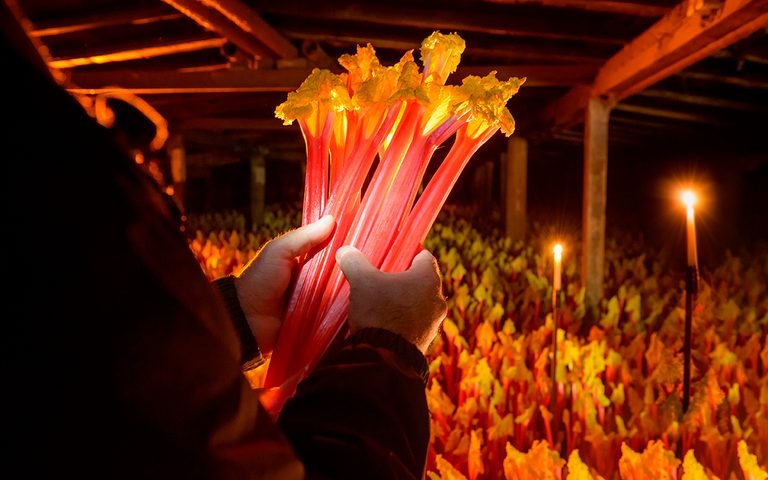
If you have seen my Theme Reveal for the A2Z Challenge 2022, then you will know that I am writing about becoming Vegetarian gradually as a response to the crisis in food supply chains sparked by the pandemic and made worse by the WAR in Ukraine. As well, I am keeping to the theme I originally planned of food which can be eaten in its own right as well as becoming an ingredient in other dishes…

There are two themes running through my A2Z challenge this year and whilst you may think that rhubarb and Mercantilism are pretty random blog-fellows, in fact, the one illustrates the historical application of the other nearly perfectly! Some years ago, I was reading the lengthy series of historical novels – Poor Man at the Gate, by Andrew Wareham when I came across a passage in which the protagonist, by this time a member of the government, was discussing the reasons for a chronic shortage of silver in circulation. The reason given was that the Chinese were insisting on being paid for goods, not in trade for other goods, but exclusively in silver. The goods we so wanted, were silk, tea and rhubarb! I did a double-take thinking “how would you even ship rhubarb halfway around the world?” I had to investigate… The Chinese were acting out Mercantilism, one of the tenets of which, was that you should try to accumulate silver and gold to make a country rich, and you did that by trade restrictions – restrictions on imports and pushing exports for hard currency. The opposite philosophy, which came in the mid-19th century, was liberalism which pushes entrepreneurship and free trade – Liberalism favours individuals getting wealthy whereas Mercantilism favours the State accumulating money. Mercantilism confuses monetary wealth with the wealth that a wide selection of goods offers. The state – which is big in mercantilism, may grow wealthy in money, but the population came off badly. The British tried to get around the import bans by trading with merchants upstream from the government and eventually resorted to selling opium and getting a nation hooked on it – not one of our finest hours… The Chinese government retaliated by completely withholding the rhubarb – of course, it was not the fruit, but the powdered root which had medicinal value – it was touted as a cure for digestive disorders, flatulence and constipation. So much of the medicine did we buy, that the Chinese reasoned that we Brits must be really bunged up and that withholding the vital rhubarb would soon bring us to our knees – perhaps literally! If you want to read more fulsome explanations of Mercantilism then you can find them here and here.
The thing is, mercantilism has never really gone away, indeed the Chinese (and several other south-east Asian countries) have done very well for their economies by practising this economic philosophy whilst in the US and Europe, we have embraced the liberal and neo-liberal philosophies – there has been some meeting in the middle with globalism – China, South Korea and Taiwan exported lots of geegaws to the West which our consumers happily consumed, but with the fallout from the war in Ukraine threatening globalism, a resurgence of protectionist policies – apart of mercantilism is on the cards…
Enough with the economic philosophy stuff – now to the fun bit – Rhubarb as food! Rhubarb is properly speaking, a vegetable that we happen to regard as a fruit. It is the petiole, or leaf stem that we eat, never the leaves which are quite poisonous – containing a lot of oxalic acid – very bad for your kidneys. The fleshy stems can even be eaten raw – especially when young and tender – my partner used to eat it as a child, by dipping the end in sugar… Rhubarb stems contain vitamin K and also the antioxidants – anthocyanins (which give it its red color) and proanthocyanidins. Brought to Europe for its medicinal properties, the increasing cheapness of sugar, meant that by the 18th century, rhubarb was transitioning to culinary usage. It needs sugar because it is quite tart or acid so although it is a favourite in pies and crumbles, it is also (like gooseberries) a good sauce element to serve with oily fish like Mackerel. I have shot myself in the foot for a recipe by talking about Rhubarb and Ginger jam in my post about ginger, for this is a classic pairing. I also talked about how to concentrate young and tender rhubarb stems so they don’t cook to mush and that technique can be used for any soft fruit that has the same tendency – such as strawberries. Strawberries are also sometimes paired with rhubarb – to the disgust of rhubarb purists…

I will leave you with this magical image of the forcing sheds where early season rhubarb is picked by candlelight for early season, extra sweet shoots. We live near the Yorkshire Rhubarb Triangle where such sheds abound, if you live in the US, then half of all rhubarb comes from Pierce County, Washington. Here in Yorkshire, this is the time of year…